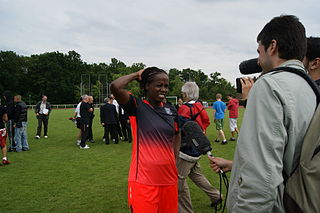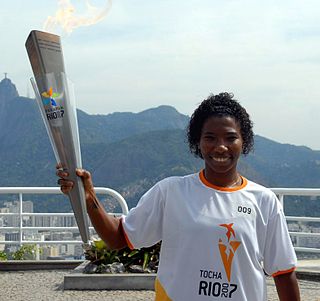
Hércules de Brito Ruas,, known as Brito, is a former Brazilian footballer. He played as a central defender for several clubs, and for the Brazil national team.

Iomar do Nascimento, known as Mazinho, is a Brazilian football manager and former player. Mazinho played primarily as a defensive midfielder and a full-back in his professional playing career. As a manager, he had a short spell at Greek club Aris in 2009.

Carlos Germano Schwambach Neto, better known as Carlos Germano, is a former Brazilian footballer who played goalkeeper.
Sisleide do Amor Lima, commonly known as Sissi, is a Brazilian footballer and coach who played as an attacking midfielder. She last played for FC Gold Pride of Women's Professional Soccer and is a former member of the Brazil women's national football team.

Kátia Cilene Teixeira da Silva, known simply as Kátia, is a Brazilian former footballer.

Ester Aparecida dos Santos, commonly known mononymously as Ester, is a Brazilian former footballer. She played as a "volante" for clubs including Chelsea of the English FA WSL and BV Cloppenburg of the German Frauen-Bundesliga. Ester was part of the Brazil women's national football team who finished as runners-up in the 2007 World Cup and 2008 Summer Olympics.

Delma Gonçalves, commonly known as Pretinha, is a Brazilian professional soccer coach and former forward. A longtime member of the Brazil national team, for whom she debuted in 1991, she played for clubs in Brazil, the United States and Japan before moving to Icheon Daekyo of South Korea's WK-League in 2009.

Bárbara Micheline do Monte Barbosa, commonly known as Bárbara, is a Brazilian professional footballer who plays as a goalkeeper for Série A1 club CR Flamengo and the Brazil women's national team. She has played for clubs in Italy, Sweden and Germany, as well as in her native country, Brazil. Since making her national team debut in 2007, she has won over 30 caps for Brazil. She has been part of her country's squad at four editions of the FIFA Women's World Cup and at two Olympic football tournaments.
Elane dos Santos Rego, commonly known as Elane, is a Brazilian retired footballer who played as a central defender for the Brazil women's national football team.
Roseli de Belo, commonly known as Roseli, is a Brazilian footballer who played as a forward for the Brazil women's national football team.

Esporte Clube Radar was a Brazilian professional women's association football club, based in the Copacabana neighbourhood of Rio de Janeiro, Brazil. Founded as a beach football side in 1981 and restructured for association football in 1982, Radar enjoyed unprecedented success in the early days of women's football in Brazil, winning both the Taça Brasil de Futebol Feminino and the Campeonato Carioca de Futebol Feminino on six consecutive occasions during the 1980s and at one point claiming a record of only four losses in more than 300 matches played. Additionally, they would barnstorm in high-profile televised challenge matches against other Brazilian women's teams.
Rosa Maria Gomes de Lima, commonly known as Rosa, is a Brazilian retired footballer who played as a defender for the Brazil women's national football team.
Marisa Pires Nogueira, commonly known as Marisa, is a Brazilian footballer who played as a defender for the Brazil women's national football team.
Márcia Honório da Silva, commonly known as Marcinha, is a Brazilian football coach and former player. She was a midfielder for the Brazil women's national football team.
Rosilane Camargo Motta , commonly known as Fanta, is a Brazilian former football player. She was a "volante" for the Brazil women's national football team. Her nickname is derived from "Fantasma", 'ghost' or 'phantom', which was given to her by a former coach who complained about her absence in pre-game preparations.
Marilza Martins da Silva, commonly known as Pelézinha, is a Brazilian former football player, who operated as a forward for the Brazil women's national football team. Her nickname is an homage to the celebrated male footballer Pelé.
Cenira Sampaio Pereira do Prado, commonly known as Cenira, is a Brazilian former footballer who played as an attacking midfielder or playmaker for the Brazil women's national football team.

Martim Francisco Ribeiro de Andrada was a Brazilian association football coach. He is widely credited with the invention of the 4–2–4 formation when guiding his first club, the Villa Nova AC of Nova Lima, to the State Championship of Minas Gerais in 1951. He won further state championships with Atlético Mineiro of Belo Horizonte in 1953, CR Vasco da Gama of Rio de Janeiro in 1956 and SE Gama of Brasília in 1979. Other clubs he coached include Corinthians, Cruzeiro, America FC of Rio de Janeiro and Athletic Bilbao in Spain. With Bangu AC he won the State Champions' Cup of 1967.
Márcia Matos Calaça, commonly known as Russa, is a Brazilian former footballer who played as a midfielder for the Brazil women's national team.

Club de Regatas Vasco da Gama, commonly known as Vasco da Gama or simply Vasco, is a women's association football club based in Rio de Janeiro, Brazil. Founded in 1987, the team has been inactive for periods prior to its most recent reinstatement in 2016. The team is affiliated with Federação de Futebol do Estado do Rio de Janeiro and play their home games at São Januário. The team colors, reflected in their logo and uniform, are white and black. They play in the third tier of women's football in Brazil, the Campeonato Brasileiro de Futebol Feminino Série A3, and in the Campeonato Carioca de Futebol Feminino, the traditional in-state competition.









